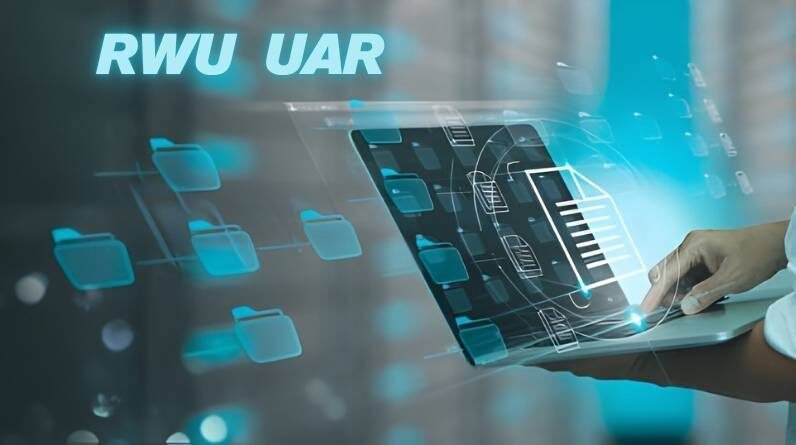Introduction
The digital world continues to evolve at a rapid pace, forcing , forcing organizations, security researchers, universities, and surveillance teams to adopt smarter, more structured approaches to data management, academic submissions, and access control. Guess , Guess what? One term that appears frequently in administrative discussions, student forums, IT documentation, and monitoring systems is rwu uar.
Although a bunch of users encounter this term during login attempts, application logins, and enterprise security operations, few have a clear understanding of what RWU UR means or why it exists. Seriously, RWU usually refers to role-based units of work, while UAR refers to user access overview. And oh yeah, This shared concept is critical across organizations and institutional frameworks to ensure that THE right people have the right level of access to digital or university resources.
Guess what? In this article, we’ll comprehensively analyze the RWU UR , explaining why it appears as a warning or requirement, how it works behind the scenes, what problems users encounter, why feeds and logs , logs record these entries, and what , what reliable workarounds currently exist. If you’ve ever wondered why RWU UR is important, read on.
Table of Contents
What Is RWU UAR?

RWU UAR is a combination of two administrative terms commonly used in academic institutions corporate security departments and digital , digital authorization workflows. Guess , Guess what? RWU focuses on departments roles and responsibilities ensuring that , that each user belongs to the correct business unit. On the other hand the UAR ensures the implementation of access control periodic reviews AND compliance monitoring.
When integrated the RWU UAR becomes a checkpoint mechanism to verify that a student , student employee or registered user has the appropriate access level associated with , with their role. The concept extends to digital , digital portals learning management systems and internal dashboards where administrators must , must set permissions to discourage unauthorized entries.
Why RWU UAR Appears in Feeds or Logs
a bunch of people get confused when they see RWU UAR entries repeatedly appearing in system feeds or activity screens. These feeds often , often act as real-time tracking monitors that record user behavior such as login attempts failed authentication permission requests or profile updates. Since , Since the RWU UR handles role and access controls the system logs all relevant events to maintain auditability. You know what?
This registration is necessary to comply with data protection laws internal policies and third-party certification frameworks. When a user’s role changes—for example from a freshman to a graduating sophomore or from an intern to an employee—the UAR process updates privileges while the RWU associates them with new responsibilities. These changes automatically generate feed , feed posts so a bunch of people encounter RWU UAR notifications without explanation.
Common Problems People Face
The most , most frustrating aspect for most students, employees or users of the portal is the lack of generally understandable documentation. RWU UAR errors indicate permission mismatches, outdated profiles, or missing , missing consent strings. Users often cannot access certain modules, documents or dashboards due to incorrect role classification. And oh yeah, Sometimes departments forget to update business units after updates, leading to bottlenecks.
Students may have , have difficulty opening new course material if the row still belongs to previous classes. Similarly, employees may lose access to internal communication platforms if the UAR review is delayed. The system rarely explains these issues clearly, causing confusion and unnecessary delay. Customer service waiting lists get longer as users , users repeatedly ask the same questions.
How RWU UAR Works Behind the Scenes
RWU UAR is part of a larger identity management ecosystem. When an institution enrolls a student or hires an employee, their personal details, department, privileges, and responsibilities are registered in a central database. During login or resource requests, the system cross-checks the user’s role with allowed permissions.
If these attributes are out of sync, RWU UAR triggers a review. The review then assigns administrators to verify whether the user should continue accessing sensitive modules. This behind-the-scenes validation protects confidential documents, prevents data leaks, and controls resource allocation. In some cases, automated systems send email notifications requesting confirmation through department supervisors to approve or downgrade permissions.
The Importance of User Access Review
User Access Reviews are essential in modern cybersecurity frameworks. Regulatory standards such as ISO 27001, GDPR, FERPA, HIPAA, and SOC compliance require routine access evaluations. These evaluations ensure individuals do not retain access to confidential data after leaving a project, graduating, resigning, or shifting departments.
Without UAR oversight, institutions could face privacy lawsuits, data theft, and financial penalties. RWU UAR plays an active role in preventing disgruntled ex-employees from accessing restricted databases. It also disables dormant accounts that attackers might exploit. Many cyber-attacks today originate through compromised unused accounts. UAR mitigates this threat efficiently.
Why Feeds and Alerts Include RWU UAR

Real-time feed systems operate as transparent monitoring tools showing who attempted to access what, when, and under which role. RWU UAR entries appear here because access reviews need documented evidence of enforcement. During external audits, inspectors can verify role assignment trails to ensure compliance. If the institution cannot provide logs, auditors consider the system vulnerable.
Therefore, RWU UAR feeds act as proof of security diligence. Often the frequency of these entries increases during semester transitions, job role promotions, departmental restructures, and system upgrades. Some institutions also enable automatic feeding to detect suspicious spikes in permission requests.
Technical Workflow
| Stage | Description | Responsible Authority |
| Role Assignment (RWU) | Allocates user to designated work unit | Department Admin |
| Access Mapping (UAR) | Determines allowed modules/tools | Security Officer |
| Periodic Review | Validates continuing privilege need | Compliance Team |
| Logging | Records each event in feed | Automated System |
| Approval Chain | Confirms or rejects access | Supervisors |
Symptoms When RWU UAR Is Misconfigured
A misconfigured RWU UAR flag can create a variety of user experience issues. Individuals may suddenly lose access to file storage servers, grading portals, library databases, internal forums, and communication groups. Sometimes faculty members fail to upload attendance because their access level downgraded without notice.
Students experience blocked exam applications, assignment uploads, or restricted dashboard visibility. Worst-case scenarios involve suspended accounts flagged as suspicious when merely undergoing role changes. These symptoms demand administrative review to restore smooth workflow.
Why You Should Not Ignore RWU UAR Flags
Users assume ignoring this flag poses no danger. However, the longer a mismatched role stays unresolved, the higher the risk of privilege decay. Once the system suspends outdated roles, recovering access requires multiple signatures. This delays academic progress or work submissions. In corporate environments, ignoring UAR warnings could break compliance chains, resulting in costly fines. Moreover, suspicious mismatched access requests can trigger security investigations. Routine attention ensures smooth system operation.
Real-World Use-Cases of RWU UAR
RWU UAR frameworks appear in almost every structured institution today. Universities use them to categorize academic years, control library resource access, and secure financial modules such as scholarship reports. Corporations control confidential project repositories, paid software licenses, and sensitive intellectual property through UAR processes.
Hospitals use role-based access to regulate medical records. Banking systems rely on periodic reviews to prevent financial fraud. Government departments enforce access compartmentalization to protect classified information. The underlying concept remains consistent: grant users only what they truly need.
Troubleshooting RWU UAR Issues
Users facing RWU UAR problems often panic, believing something is wrong with their profile. Most issues are temporary and resolve after proper administrative acknowledgment. Always contact department IT desks or access managers rather than ignoring the flag.
Provide accurate personal information such as student ID, employee number, and department code. Avoid repeated failed attempts, as they can appear in feeds as suspicious activity. Patience is important because backend approval requests may require multiple authorization layers.
Helpful Action Steps
Some paragraphs may include bullet points:
- Request official clarification from authorized staff only
- Ask whether your role category matches current status
- Confirm whether UAR review cycles have passed
- Avoid attempting resource access repeatedly
- Keep institutional email active for approval messages
These steps prevent account lockdowns and reduce administrative load.
What Happens If You Leave RWU UAR Unresolved
Leaving RWU UAR issues unresolved triggers automatic system policies. Over time, outdated accounts fall into deactivated zones. Once deactivated, recovery requires identity verification, department confirmation, and system administrator approval. Delayed response might remove assignment history, portal submissions, or financial aid visibility.
In professional environments, this might cause loss of project files, client communication access, or license permissions. It also increases risk exposure because outdated access often correlates with cybersecurity vulnerabilities. The longer the system waits, the harder it becomes to restore cleanly
Comparison: Timely vs Ignored UAR
| Factor | Timely Resolution | Ignored Resolution |
| Access Continuity | Smooth, uninterrupted | Sudden restrictions |
| Security Risk | Controlled | Elevated |
| Support Involvement | Minimal | Extensive |
| Recovery Time | Fast | Slow |
| Compliance Impact | Safe | Potential violation |
Institutional Benefits of RWU UAR
Institutions use the RWU UAR model not just for security but also for resource optimization. When users move departments, licenses they no longer need can revert to the shared pool, reducing software expenses.
When employees resign, their access termination prevents unauthorized data retention. This model also helps universities allocate lab equipment permissions to active semester students only, reducing overcrowding. The system ensures every user has just enough access to perform their duties without overreach. Additionally, it supports data segmentation, making search results faster and more relevant.
Why RWU UAR Does Not Feel User-Friendly

Although the concept is robust, the user interface often lacks clarity. Portals rarely offer intuitive explanations. Most systems cater to administrators rather than end-users, resulting in confusing pop-ups, cryptic flags, and technical jargon. Feeds display entries using abbreviated labels like RWU UAR instead of plain language descriptions.
Furthermore, training workshops typically focus on staff administrators, leaving common students and employees unsure how to interpret or resolve these messages. This usability gap generates frustration and unnecessary help desk load.
Future Improvements Expected
Developers are gradually integrating artificial intelligence-based recommendation systems into UAR workflows. These systems will identify mismatched permissions early and automatically request verification. Institutional dashboards will explain why a particular flag was raised, which departments must review it, and how long the process usually takes.
User-friendly wording will replace cryptic abbreviations. Predictive algorithms will reduce manual approval queues. Over time, RWU UAR will evolve from a confusing warning to a transparent guidance framework.
Security Hooks to Consider
Modern cyber-threats emerged due to privilege misuse. Hackers target forgotten accounts and outdated permissions because the authorized owners are unaware. RWU UAR removes weak links and strengthens internal security posture.
Institutions adopting periodic access reviews report significantly lower insider attack cases. Continuous monitoring acts as a deterrent against unauthorized lateral movement within networks. Today’s cybersecurity policies enforce least-privilege access, which RWU UAR strongly supports.
Conclusion
RWU UAR may seem , seem confusing when users first encounter it, especially in activity feeds or organizational records, but its importance cannot , cannot be underestimated. This framework ensures that each student, employee, or user of the system has access rights appropriate to their current role, while protecting sensitive information.
By effectively managing permissions, organizations protect , protect data, improve workflow continuity, and maintain compliance with international security standards. Users , Users should never ignore RWU UAR flags because they indicate A pending status check or access discrepancy.
Instead, they should contact their department or IT support team immediately to keep the system running smoothly. As digital transformation accelerates, RWU UAR continues to grow in importance, shaping how organizations manage access responsibly, transparently and securely.
FAQs
Q1: Why does RWU UAR appear so frequently in my feed?
Because the system continuously logs role-based access validations to maintain compliance and audit trails.
Q2: Who is authorized to resolve RWU UAR issues?
Typically department administrators, system security officers, or access management teams.
Q3: Can ignoring RWU UAR warnings disable my account?
Yes, prolonged unresolved mismatches can trigger automatic deactivation.
Q4: Does RWU UAR only apply to academic institutions?
No, it is widely used in corporate, medical, financial, and government environments.
Q5: How long does it usually take to get a UAR approved?
Deadlines vary depending on reviewer availability department workload AND system automation level.
Also Read This: Dangers of Best IcePornCasting Scams Online
